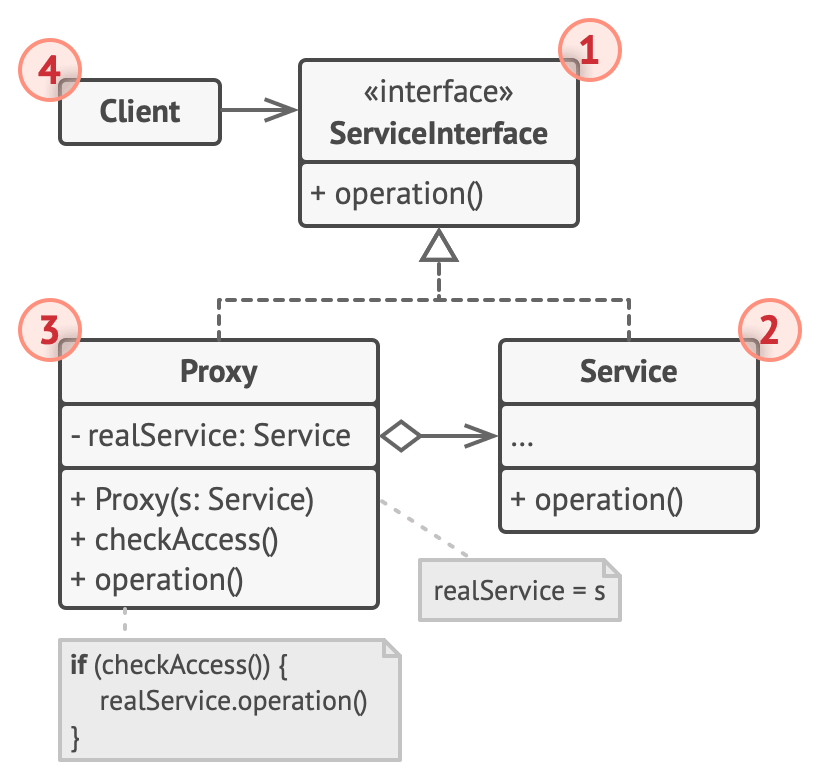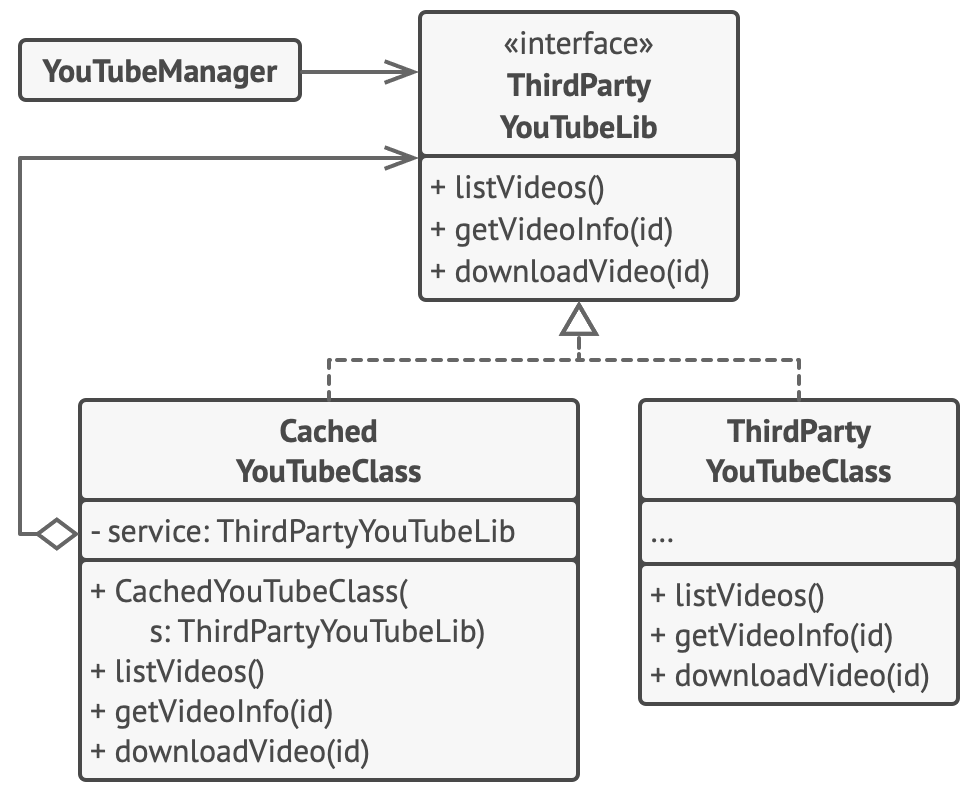| 일 | 월 | 화 | 수 | 목 | 금 | 토 |
|---|---|---|---|---|---|---|
| 1 | 2 | 3 | 4 | |||
| 5 | 6 | 7 | 8 | 9 | 10 | 11 |
| 12 | 13 | 14 | 15 | 16 | 17 | 18 |
| 19 | 20 | 21 | 22 | 23 | 24 | 25 |
| 26 | 27 | 28 | 29 | 30 | 31 |
- 로버트마틴
- Collections
- lambda calculus
- JDBC
- JavaScript
- 람다 칼큘러스
- exception
- Pattern
- Python
- Rails
- Network
- 자바
- Collection
- javscript
- 파이썬
- DesignPattern
- solid
- 큐
- Eclipse
- 겨울카카오인턴
- Java
- design-pattern
- functional programming
- 프로그래머스
- tcp
- 스택
- 함수형 프로그래밍
- Spring
- 백준
- 디자인패턴
- Today
- Total
개발자 노트
Proxy Pattern 본문
참고자료
-
proxy : 대리인, 대용물
ProxyPattern이란?
- structual design-pattern
- 실제 서비스에 대해 대리인을 둠으로써 클라이언트가 실제 서비스 접근하는 것을 대리인이 컨트롤할 수 있는 패턴입니다.
상황 - 언제 실 서비스 접근에 대한 컨트롤이 필요할까?

- DB에 접속하여 서비스의 많은 리소스를 잡아먹을 수 있는 object가 있습니다.
- 이 object는 때때로 실행됩니다.
이를 위해 lazy initialization을 생각해볼 수 있습니다.
다시 말해서 필요한 순간에 object를 생성하여 DB에 접근하도록 컨트롤하고 싶은 상황입니다.
안 좋은 접근
-
object를 사용하는 client 코드들을 lazy initialization으로 수정
- client 하나하나 수정해야하기 때문에 코드 중복이 발생할 수 있습니다.
-
object 자체를 lazy initialization으로 수정
- object가 3rd-party library일 경우 수정할 수가 없습니다.
해결책 - 대리인을 두어라!

-
위 그림처럼 database와 interface가 동일한 proxy class를 앞에 둡니다.
-
그리고 클라이언트가 database가 아닌, proxy에 대해 요청을 하도록 합니다.
-
클라이언트가 요청시 proxy에서 object를 초기화하여 실 서비스에 대해 로직을 수행하도록 합니다.
구조

1. ServiceInterface
Proxy와 Service가 동일한 인터페이스를 가지도록 하기 위해 Service의 인터페이스를 생성합니다.
2. Service
서비스는 실제 비즈니스의 로직이 있는 부분입니다.
3.Proxy
프록시는 service에 대해 reference field를 지니고 있습니다. 작업을 위임하고, 컨트롤하기 위해서 이지요.
4. Client
클라이언트는 Proxy를 실 서비스처럼 사용합니다.
사용 예
- lazy initialization
- 보안
- 실서비스 접근 시 proxy가 사용자 권한을 확인하여 접근을 허용할 지, 거부할 지 판단
- 로깅
- 캐싱
예시 - 유튜브 캐싱 라이브러리

1. ThirdParty YouTubeLib
public interface ThirdPartyYouTubeLib {
HashMap<String, Video> popularVideos();
Video getVideo(String videoId);
}2.ThirdPartyYouTubeClass
public class ThirdPartyYouTubeClass implements ThirdPartyYouTubeLib {
@Override
public HashMap<String, Video> popularVideos() {
connectToServer("http://www.youtube.com");
return getRandomVideos();
}
@Override
public Video getVideo(String videoId) {
connectToServer("http://www.youtube.com/" + videoId);
return getSomeVideo(videoId);
}
// -----------------------------------------------------------------------
// Fake methods to simulate network activity. They as slow as a real life.
private int random(int min, int max) {
return min + (int) (Math.random() * ((max - min) + 1));
}
private void experienceNetworkLatency() {
int randomLatency = random(5, 10);
for (int i = 0; i < randomLatency; i++) {
try {
Thread.sleep(100);
} catch (InterruptedException ex) {
ex.printStackTrace();
}
}
}
private void connectToServer(String server) {
System.out.print("Connecting to " + server + "... ");
experienceNetworkLatency();
System.out.print("Connected!" + "\n");
}
private HashMap<String, Video> getRandomVideos() {
System.out.print("Downloading populars... ");
experienceNetworkLatency();
HashMap<String, Video> hmap = new HashMap<String, Video>();
hmap.put("catzzzzzzzzz", new Video("sadgahasgdas", "Catzzzz.avi"));
hmap.put("mkafksangasj", new Video("mkafksangasj", "Dog play with ball.mp4"));
hmap.put("dancesvideoo", new Video("asdfas3ffasd", "Dancing video.mpq"));
hmap.put("dlsdk5jfslaf", new Video("dlsdk5jfslaf", "Barcelona vs RealM.mov"));
hmap.put("3sdfgsd1j333", new Video("3sdfgsd1j333", "Programing lesson#1.avi"));
System.out.print("Done!" + "\n");
return hmap;
}
private Video getSomeVideo(String videoId) {
System.out.print("Downloading video... ");
experienceNetworkLatency();
Video video = new Video(videoId, "Some video title");
System.out.print("Done!" + "\n");
return video;
}
}3. Video
public class Video {
public String id;
public String title;
public String data;
Video(String id, String title) {
this.id = id;
this.title = title;
this.data = "Random video.";
}
}4. caching Proxy
public class YouTubeCacheProxy implements ThirdPartyYouTubeLib {
private ThirdPartyYouTubeLib youtubeService;
private HashMap<String, Video> cachePopular = new HashMap<String, Video>();
private HashMap<String, Video> cacheAll = new HashMap<String, Video>();
public YouTubeCacheProxy() {
this.youtubeService = new ThirdPartyYouTubeClass();
}
@Override
public HashMap<String, Video> popularVideos() {
if (cachePopular.isEmpty()) {
cachePopular = youtubeService.popularVideos();
} else {
System.out.println("Retrieved list from cache.");
}
return cachePopular;
}
@Override
public Video getVideo(String videoId) {
Video video = cacheAll.get(videoId);
if (video == null) {
video = youtubeService.getVideo(videoId);
cacheAll.put(videoId, video);
} else {
System.out.println("Retrieved video '" + videoId + "' from cache.");
}
return video;
}
public void reset() {
cachePopular.clear();
cacheAll.clear();
}
}4. YouTubeDownloader
public class YouTubeDownloader {
private ThirdPartyYouTubeLib api;
public YouTubeDownloader(ThirdPartyYouTubeLib api) {
this.api = api;
}
public void renderVideoPage(String videoId) {
Video video = api.getVideo(videoId);
System.out.println("\n-------------------------------");
System.out.println("Video page (imagine fancy HTML)");
System.out.println("ID: " + video.id);
System.out.println("Title: " + video.title);
System.out.println("Video: " + video.data);
System.out.println("-------------------------------\n");
}
public void renderPopularVideos() {
HashMap<String, Video> list = api.popularVideos();
System.out.println("\n-------------------------------");
System.out.println("Most popular videos on YouTube (imagine fancy HTML)");
for (Video video : list.values()) {
System.out.println("ID: " + video.id + " / Title: " + video.title);
}
System.out.println("-------------------------------\n");
}
}5. Demo
public class Demo {
public static void main(String[] args) {
YouTubeDownloader naiveDownloader = new YouTubeDownloader(new ThirdPartyYouTubeClass());
YouTubeDownloader smartDownloader = new YouTubeDownloader(new YouTubeCacheProxy());
long naive = test(naiveDownloader);
long smart = test(smartDownloader);
System.out.print("Time saved by caching proxy: " + (naive - smart) + "ms");
}
private static long test(YouTubeDownloader downloader) {
long startTime = System.currentTimeMillis();
// User behavior in our app:
downloader.renderPopularVideos();
downloader.renderVideoPage("catzzzzzzzzz");
downloader.renderPopularVideos();
downloader.renderVideoPage("dancesvideoo");
// Users might visit the same page quite often.
downloader.renderVideoPage("catzzzzzzzzz");
downloader.renderVideoPage("someothervid");
long estimatedTime = System.currentTimeMillis() - startTime;
System.out.print("Time elapsed: " + estimatedTime + "ms\n");
return estimatedTime;
}
}마무리
The proxy could interface to anything: a network connection, a large object in memory, a file, or some other resource that is expensive or impossible to duplicate.
In short, a proxy is a wrapper or agent object that is being called by the client to access the real serving object behind the scenes.
디자인 패턴을 10개 넘게 소개하면서 눈에 띄는 객체관계가 있습니다. 바로 aggregation, composition입니다. 결국 이 패턴을 쓰는 이유는 2가지로 볼 수 있습니다.
- 작업을 위임할 수 있다.
- 서비스를 곧 바로 실행하는 것이 아닌, 해당 object를 통해 실 작업을 실행하기 때문에 해당 Object에 대한 로직을 넣을 수 있습니다.
'디자인패턴 > Structural Design Pattern' 카테고리의 다른 글
| Flyweight Pattern (0) | 2020.10.12 |
|---|---|
| Facade Pattern (0) | 2020.10.12 |
| Decorator Pattern (0) | 2020.10.12 |
| Composite Pattern (0) | 2020.10.12 |
| Bridge Pattern (0) | 2020.10.11 |
